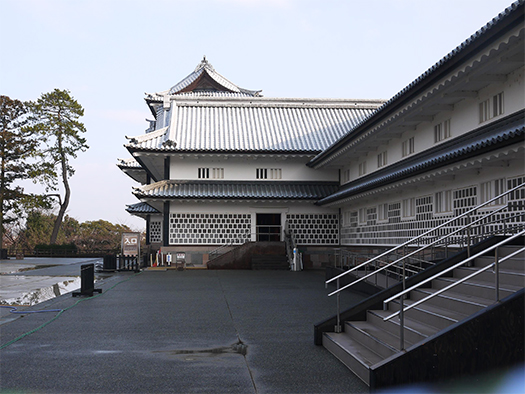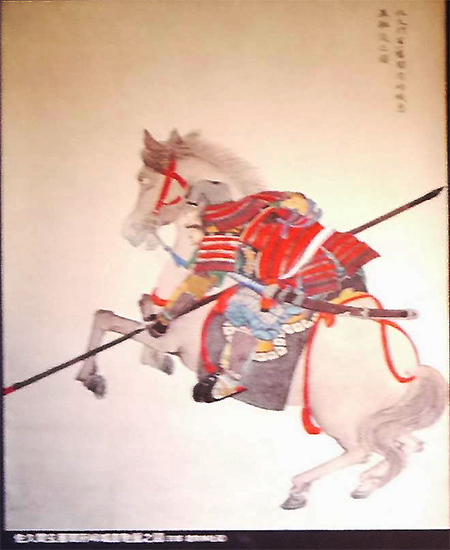

本日も「金沢城」についてであります。歴史と建築の探訪は加齢とともに興味が深くなって仕方ありません。最近、量子物理学の研究者である田坂広志さんという方の「死は存在しない」という本を読み進めています。〜これまでの唯物論に基づく科学は、死後の世界の存在を否定してきた。それゆえ、死後の世界を肯定する宗教とは決して交わることが無かった。しかし近年、最先端量子科学が、一つの興味深い「仮説」を提示している。その「新たな仮説」は、「死後の世界」が存在する可能性を示唆している。〜っていうような刺激的な領域なんですね。
わたしのような歴史大好き人間には、最先端科学とのきわめて有力な接点と感じられてやや興奮しております。昔人と現代人との時間を超えた対話ということからも近縁的だと思っています。書かれている言語の科学的厳密性にぐいぐいと引っ張られながら、自らの加齢を客観的に「見極める」ような心境であります。この読書体験についてはまた、徐々にまとめたいと考えています。
大きく横道ですが、歴史の中の人物に迫っていく、同時にその残した建築・住宅についても最先端の迫り方があり得ますね。とくに金沢は宗教勢力と専制権力との修羅が繰り広げられていた。宗教というものがある種、超常的な人間体験を基礎として成立して来たものであるのに対して、軍事による専制体制、強力な中央権力による「現世利害」の貫徹・勝利という側面がみえる。
この金沢城は、一向一揆の拠点である「金沢御堂」がその起点だとされています。1546(天正15)年、本願寺から僧侶が下向し「寺内町」が形成された。「御堂」というのは戦国期の一向宗宗教勢力の一種の城郭。大きく文化発展した北陸金沢の地は、地政的軍事的に枢要な地であったことが伝わってくる。一向宗がさかんだった北陸地方の門徒衆がその信仰の中心として経済的にも政治的にも本願寺を支える一大勢力になった。
その宗教勢力根拠地を攻撃したのが、織田信長軍。全国でこの戦国の最終戦は苛烈をきわめて戦われた。事実上の日本の国内戦の最大の局面だったのだと思われます。
その戦いは織田軍、柴田勝家とその甥の佐久間盛政による金沢御堂の占領によって終結した。そして占領後、佐久間盛政は一揆勢の反撃からこの要地を防御するために、さかんに城郭建築を行っていった。いまに残る金沢城の原形とされる。図は佐久間盛政の武人としての肖像。
English version⬇
Oda’s Army, Sakuma Morimasa and the Kanazawa Temple, Kanazawa Castle-2
Kanazawa Midou, the site of the final war in the Warring States period, where the religion based on supernatural phenomena and Oda Nobunaga’s army’s principle of action, “If you die, you have nothing” can be seen. …
Today, again, I would like to talk about Kanazawa Castle. Exploring history and architecture is something that interests me more and more as I age. Recently, I have been reading a book titled “Death Does Not Exist” by Hiroshi Tasaka, a quantum physics researcher. 〜˜Till now, science based on materialism has denied the existence of an afterlife. Therefore, it has never been in agreement with religions that affirm the existence of an afterlife. In recent years, however, cutting-edge quantum science has proposed an interesting hypothesis. This “new hypothesis” suggests the possibility of the existence of an afterlife. 〜It is such an exciting area, isn’t it?
For a history buff like myself, I am somewhat excited because I feel that this is an extremely powerful connection with cutting-edge science. I think it’s also closely related to the timeless dialogue between the ancients and moderns. I am being pulled along by the scientific rigor of the written language, and I feel as if I am objectively “assessing” my own aging. I hope to write more about this reading experience in due course.
This is a bit of a side road, but I think it is possible to approach historical figures and, at the same time, to approach the architecture and housing they left behind in a cutting-edge way. Especially in Kanazawa, a battle between religious forces and tyrannical power was being waged. Religion was based on a kind of supernatural human experience, whereas tyranny was based on military rule and the triumph of powerful central authority over the interests of the present world.
The starting point of Kanazawa Castle is said to be the “Kanazawa Godo,” which was the base of the Ikko Putsch. 1546, priests from Honganji Temple were sent down to form the “Terauchi-machi” (temple town). The “Midou” was a kind of fortress for the religious power of the Ikkyu sect during the Warring States period. The Hokuriku Kanazawa area, which had developed into a major cultural center, was an important geopolitical and military center. The Hokuriku area, where the Ikkyu Sect was flourishing, became the center of religious belief and a major force supporting Honganji both economically and politically.
Oda Nobunaga’s army attacked the religious power’s stronghold. This final battle of the warring states period was fought with great intensity throughout the country. It was probably the greatest phase of de facto domestic warfare in Japan.
The battle ended with the capture of the Kanazawa Palace by Oda’s forces, Katsuie Shibata and his nephew Morimasa Sakuma. After the capture, Morimasa Sakuma began construction of a castle to defend this strategic location against the counterattack of the revolting forces. This is said to be the original form of Kanazawa Castle that remains today. The figure is a portrait of Sakuma Morimasa as a warrior.
Posted on 11月 29th, 2024 by 三木 奎吾
Filed under: 日本社会・文化研究, 歴史探訪







コメントを投稿
「※誹謗中傷や、悪意のある書き込み、営利目的などのコメントを防ぐために、投稿された全てのコメントは一時的に保留されますのでご了承ください。」
You must be logged in to post a comment.